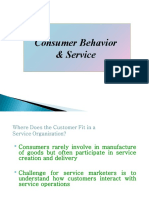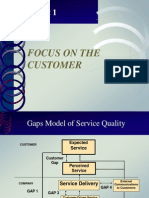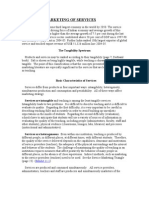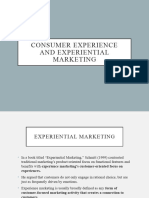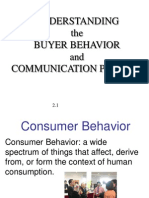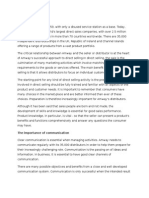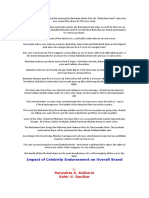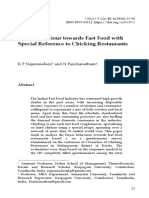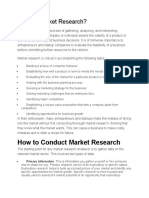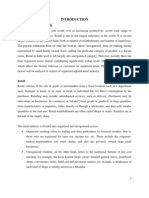0 ratings0% found this document useful (0 votes)
42 viewsDifference of Consumer Behaviour Between Services and Goods
Difference of Consumer Behaviour Between Services and Goods
Uploaded by
manish9890This document discusses differences in consumer behavior between goods and services. It notes that services have higher experience and credence qualities that are more difficult for consumers to evaluate before and after purchase. The document also outlines the basic consumer decision making process, including need perception, information search, evaluation of alternatives, purchase and consumption, and post-purchase evaluation. It describes additional factors that influence consumer behavior for services, such as physical environment, service roles, script, and compatibility with other customers. Finally, it discusses the role of culture in services marketing and differences between household and organizational consumer behavior.
Copyright:
© All Rights Reserved
Available Formats
Download as PPT, PDF, TXT or read online from Scribd
Difference of Consumer Behaviour Between Services and Goods
Difference of Consumer Behaviour Between Services and Goods
Uploaded by
manish98900 ratings0% found this document useful (0 votes)
42 views12 pagesThis document discusses differences in consumer behavior between goods and services. It notes that services have higher experience and credence qualities that are more difficult for consumers to evaluate before and after purchase. The document also outlines the basic consumer decision making process, including need perception, information search, evaluation of alternatives, purchase and consumption, and post-purchase evaluation. It describes additional factors that influence consumer behavior for services, such as physical environment, service roles, script, and compatibility with other customers. Finally, it discusses the role of culture in services marketing and differences between household and organizational consumer behavior.
Original Description:
Consumer Behaviour
Original Title
03 Consumer Behaviour-S(1)
Copyright
© © All Rights Reserved
Available Formats
PPT, PDF, TXT or read online from Scribd
Share this document
Did you find this document useful?
Is this content inappropriate?
This document discusses differences in consumer behavior between goods and services. It notes that services have higher experience and credence qualities that are more difficult for consumers to evaluate before and after purchase. The document also outlines the basic consumer decision making process, including need perception, information search, evaluation of alternatives, purchase and consumption, and post-purchase evaluation. It describes additional factors that influence consumer behavior for services, such as physical environment, service roles, script, and compatibility with other customers. Finally, it discusses the role of culture in services marketing and differences between household and organizational consumer behavior.
Copyright:
© All Rights Reserved
Available Formats
Download as PPT, PDF, TXT or read online from Scribd
Download as ppt, pdf, or txt
0 ratings0% found this document useful (0 votes)
42 views12 pagesDifference of Consumer Behaviour Between Services and Goods
Difference of Consumer Behaviour Between Services and Goods
Uploaded by
manish9890This document discusses differences in consumer behavior between goods and services. It notes that services have higher experience and credence qualities that are more difficult for consumers to evaluate before and after purchase. The document also outlines the basic consumer decision making process, including need perception, information search, evaluation of alternatives, purchase and consumption, and post-purchase evaluation. It describes additional factors that influence consumer behavior for services, such as physical environment, service roles, script, and compatibility with other customers. Finally, it discusses the role of culture in services marketing and differences between household and organizational consumer behavior.
Copyright:
© All Rights Reserved
Available Formats
Download as PPT, PDF, TXT or read online from Scribd
Download as ppt, pdf, or txt
You are on page 1of 12
SERVICES MARKETING
Consumer behaviour in Services
DIFFERENCE OF CONSUMER BEHAVIOUR BETWEEN
SERVICES AND GOODS
How does a customer differentiate & evaluate goods/services;
1. Qualities (which he can determine before purchasing)
Search of quality can be estimated before purchase or
consumption of services e.g. price, convenience, the way the
service is performed by the people and promptness of the service
or the response
when a customer orders for food for home delivery, he takes into
account the price, the delivery time and the way the delivery man
delivers and politely talks
Since it is easy to evaluate, the goods will be high in search
qualities
SERVICES MARKETING
Consumer behaviour in Services
2. Experience quality (colour, style, price, fit, feel, smell, taste
etc.)
Services have higher experience characteristics than goods
A passenger traveling by air would rate on the aspects like
courtesy of the cabin-crew, departure and arrival in time, quality
of food offered etc OR a person eating out would rate the
restaurant on the aspects of the courtesy shown by the people
taking/serving orders, quality of food, quantity of food served,
the dcor of the seating place, and other aesthetics,
surroundings etc
The services high in experience qualities are Meals at
restaurants, vacations at locations or outings at resorts,
haircut etc
SERVICES MARKETING
Consumer behaviour in Services
3. Credence qualities the qualities which even after use are
difficult to assess
The user will use the product/service on the basis of the claims
of the company, but may not be able to assess even after use
While taking a medical advice for surgery, it is difficult to
assess if the operation or medicines are necessary OR your
car repair based on the assessment of the service stations, but
difficult to assess if the diagnosis was correct and necessary
The services high in credence quality are medical, legal,
auto repair, repair of consumer durables etc.
SERVICES MARKETING
Consumer behaviour in Services
BASIC CONSUMER DECISION MAKING PROCESS
Five decision making categories are as under;
1. Need Perception
Physiological the basic need of food, water, clothing
Safety & Security Shelter & Protection
Social Friends / relations / colleagues etc
Ego after achieving success / accomplishment getting self
esteem
Self actualisation motivating yourself for education / hard
working / competing etc
SERVICES MARKETING
Consumer behaviour in Services
2. Information search
Personal search (friends and experts)
Non-personal search (mass or selective media)
However in the case of services, the perceived risk is much
higher since services are in-tangible
The services are non-standardised, and therefore un-
certainty about outcome and consequences will always be
there
Service purchases may involve more risks, as these are not
warranted or guaranteed
SERVICES MARKETING
Consumer behaviour in Services
3. Evaluation of alternatives
In case of goods, a person visits market (a store or any
other stocking point), while in the case of services, he visits
the establishment of the service provider (like bank)
In the case of services, the number of providers of a
service, are limited or may be one or two, while the goods
suppliers are normally high
Difficult to get pre-purchase information about services
In the case of services therefore the choice is limited as
compared to goods
SERVICES MARKETING
Consumer behaviour in Services
4. Purchase and consumption
Since services are experiences, Emotions and Moods
influence peoples perceptions and evaluations (moods are
transient feelings occurring at specific times and situations
while emotions are more intense, stable and pervasive
Performance by service actors (a chef showing at a
restaurant the way he prepares a dish, a bar man showing a
cocktail being made, a visit to hospital where in the earlier
case, a nurse did a fine job, in legal service, medical or
education, the roll of doctors, lawyers, or professors)
Physical setting of service (how the restaurant, room dcor
in a hotel, etc)
SERVICES MARKETING
Consumer behaviour in Services
Service roles (a hostess at a restaurant to wish and
receive, see the number of people and then guide to the
desired/available table, in airlines caring for an aged person
on wheelchair to plane)
The sequence of happenings called as script (in a hotel,
receiving, guiding to reception, attending at the counter,
allotment of the room, accompanying and carrying of the
luggage)
Compatibility with other customers (in a hotel or restaurant
or club, if you are the only customer, the feeling is different
while if you have some important people to mix up). In the
extreme case the place becomes too crowded, you may not
like to have service next time. The customers can be in-
compatible due to different faiths, beliefs, values, age,
health etc.
SERVICES MARKETING
Consumer behaviour in Services
5. Post-purchase Evaluation
In the case the customers are dissatisfied, with goods,
may attribute their dissatisfaction to a number of sources
(like bad quality, bad producer/dealer, even themselves),
while in the case of services, since they participate in
defining and production of services, they may feel more
responsible for their selection
To improve this or get a feedback many a companies have
started LOYALTY programme for retaining the customers
SERVICES MARKETING
Consumer behaviour in Services
ROLE OF CULTURE IN SERVICES
Culture is transmitted from one generation to other by the
process of learning, sharing and training
It plays an important role in services marketing
Based on the behaviour and attitudes of the employees, the
customer evaluates and uses service
It is therefore sometimes very difficult to be an international
Service provider unless the culture and values of other country is
woven into the systems
Culture Includes:
Values and attitudes differ across culture and people of a
culture may think something as right while others may not
like
SERVICES MARKETING
Consumer behaviour in Services
Manners and customs decide the ways of behaviour
Material culture cars, houses, clothes and furniture are
examples of material culture
Aesthetics refers to ideas about good looking and taste
Educational and social institutions the type of training or
teachings to be imparted, interactions among students in the
class or hospitals etc
SERVICES MARKETING
Consumer behaviour in Services
HOUSEHOLD and ORGANISATIONAL CONSUMER BEHAVIOUR
Though the difference as in both cases more than one person is
involved in the decision making but still there is a major difference;
Household consumers also would decide jointly or collectively, but
since the number of people are much smaller in numbers and the
senior members are supposed to be more intelligent and
experienced, the decision may finally be what the senior member of
the family says
Organisational consumers have to work like a team and they are
more specialised in the field for the selection. They have to identify
the needs of a collective group of people, in the interest of the
organisation.
However even here also the decision is sometimes influenced and
imposed by a senior executive
You might also like
- Services Marketing: Consumer Behavior in Services Unit 2Document78 pagesServices Marketing: Consumer Behavior in Services Unit 2mpsrishaNo ratings yet
- CHCECE021Document4 pagesCHCECE021Soniya GhisingNo ratings yet
- CHAPTER 3 Principles of Customer ServiceDocument47 pagesCHAPTER 3 Principles of Customer ServiceZhi En WongNo ratings yet
- Services Marketing 2 - Consumer Behavior in ServicesDocument50 pagesServices Marketing 2 - Consumer Behavior in ServicesAnkapa Naidu DamaNo ratings yet
- Consumer Behavior in ServicesDocument50 pagesConsumer Behavior in ServicesMangesh KandalgaonkarNo ratings yet
- UNIT 2 SMDocument49 pagesUNIT 2 SMpranaymishra95544No ratings yet
- Lesson-2-4 Consumer Behavior in ServicesDocument37 pagesLesson-2-4 Consumer Behavior in ServicesMuhammad Akmal HussainNo ratings yet
- Chapter 2 ServiceDocument12 pagesChapter 2 Serviceabdelamuzemil8No ratings yet
- Service Marketing Unit 2Document134 pagesService Marketing Unit 2Shagun PathaniaNo ratings yet
- Consumer Behavior in ServicesDocument22 pagesConsumer Behavior in ServicesViswajeet BiswalNo ratings yet
- Consumer Behaviour in ServicesDocument15 pagesConsumer Behaviour in Servicessahana_pradeep8726No ratings yet
- Title of The Paper: Sales and Distribution ManagementDocument3 pagesTitle of The Paper: Sales and Distribution ManagementAmith MashimadeNo ratings yet
- AttachmentDocument34 pagesAttachmentshemsutemam7716No ratings yet
- Session 7 Cutomer Care in Provision of Pharmaceutical ServicesDocument15 pagesSession 7 Cutomer Care in Provision of Pharmaceutical Servicesaiinocent7719No ratings yet
- Consumer Behavior in ServicesDocument9 pagesConsumer Behavior in ServicesAshokNo ratings yet
- FFSODocument28 pagesFFSOrenaroselaudNo ratings yet
- Differences Between Marketing of Goods and ServicesDocument4 pagesDifferences Between Marketing of Goods and ServicesArunNo ratings yet
- Marketing Assignment 5Document3 pagesMarketing Assignment 5Fariha pervaiz FarihaNo ratings yet
- FUNDAMENTAL Lesson 3Document39 pagesFUNDAMENTAL Lesson 3MARVILYN CLARONo ratings yet
- 08 Consumer Behavior in ServicesDocument6 pages08 Consumer Behavior in ServicesJiveta Chaudhary GroverNo ratings yet
- Service Marketing Unit 2Document36 pagesService Marketing Unit 2Vivek ArnoldNo ratings yet
- 1 Services Marketing ch-1Document22 pages1 Services Marketing ch-1irfan sNo ratings yet
- Qassist: Getting To Know The Aged Care Quality Standards For Aged Care StaffDocument25 pagesQassist: Getting To Know The Aged Care Quality Standards For Aged Care Stafflailatul husnaNo ratings yet
- Guestology With Minor Quality ControlDocument45 pagesGuestology With Minor Quality ControlElvie SuarezNo ratings yet
- Services Marketing L2.1 W2Document42 pagesServices Marketing L2.1 W2nauman bashirNo ratings yet
- CH 2 ServDocument5 pagesCH 2 Servcherinet 222No ratings yet
- Consumer Behavior MKT 750Document25 pagesConsumer Behavior MKT 750diginoseNo ratings yet
- Service Marketing: BY, Bhavithra AsokanDocument20 pagesService Marketing: BY, Bhavithra AsokanDomnic SavioNo ratings yet
- Consumer Behavior & ServiceDocument21 pagesConsumer Behavior & ServiceAbhi MalhotraNo ratings yet
- Skills of Customer Care To Improve Quality of ServiceDocument37 pagesSkills of Customer Care To Improve Quality of ServiceDeogratiusRemmyNo ratings yet
- Analyzing Customer's SatisfationDocument19 pagesAnalyzing Customer's SatisfationTom RosellNo ratings yet
- HCM 437 Advanced Food and Beverage ServiceDocument137 pagesHCM 437 Advanced Food and Beverage Servicevictor-manuel-molina-6007100% (2)
- Marketing of Services: Marketing Society of Kenya BY B.W.MainaDocument49 pagesMarketing of Services: Marketing Society of Kenya BY B.W.MainanobleconsultantsNo ratings yet
- Consumer BehaviourDocument30 pagesConsumer BehaviourManoj BaghelNo ratings yet
- Chapter 3Document9 pagesChapter 3cbdm6j8qqvNo ratings yet
- CH 5 5057Document21 pagesCH 5 5057Negash adaneNo ratings yet
- Role and Function of The MidwifeDocument35 pagesRole and Function of The Midwifenessa100% (7)
- How Does Cultural Factors Impact Change in Customer Expectations?Document16 pagesHow Does Cultural Factors Impact Change in Customer Expectations?Manish AroraNo ratings yet
- Service QualityDocument14 pagesService Qualitywangechinjoroge.jNo ratings yet
- Unit-4Relationship Marketing, Consumer BehaviorDocument33 pagesUnit-4Relationship Marketing, Consumer BehaviorSumaira KhanNo ratings yet
- Unit FinalDocument24 pagesUnit Final672000sapnasinghNo ratings yet
- What Are ServicesDocument13 pagesWhat Are Serviceskartheek_aldiNo ratings yet
- Unit 1 CBDocument51 pagesUnit 1 CBsinghs9415No ratings yet
- CH-1 BB For ClassDocument50 pagesCH-1 BB For ClassSarah MuktarNo ratings yet
- Focus On The CustomerDocument11 pagesFocus On The Customerimran20bestNo ratings yet
- Marketing of Services ND Ims...Document16 pagesMarketing of Services ND Ims...ऋषिकेश सिंह गौतमNo ratings yet
- SMK - Session Customer Perceptions of ServiceDocument27 pagesSMK - Session Customer Perceptions of ServiceMunch MuchNo ratings yet
- MKT 2106 - Chap 3 Retail Quality and ServiceDocument60 pagesMKT 2106 - Chap 3 Retail Quality and ServiceTan HuitingNo ratings yet
- SM C3 Consumer BehaviorDocument48 pagesSM C3 Consumer BehaviormamuntextileNo ratings yet
- Module 4 - Customer ExperienceDocument11 pagesModule 4 - Customer ExperienceJathin InnaniNo ratings yet
- COMMUNICATION SESSION 08Document23 pagesCOMMUNICATION SESSION 08Michael nyunjaNo ratings yet
- Counseling For FP Use For ClassDocument61 pagesCounseling For FP Use For ClassYonas TsagayeNo ratings yet
- Session 7-Customer Care in Provion of Pharmaceutical ServicesDocument18 pagesSession 7-Customer Care in Provion of Pharmaceutical Servicesmartingerwin9No ratings yet
- Chapter 3 Tourism and Consumer BehaviorDocument25 pagesChapter 3 Tourism and Consumer BehaviorKyla LimNo ratings yet
- Factors Affecting Consumer BehaviorDocument9 pagesFactors Affecting Consumer Behaviorraam06No ratings yet
- Amity Consumer BehaviorDocument240 pagesAmity Consumer BehaviorAjit JainNo ratings yet
- Understanding The Buyer Behavior and Communication ProcessDocument26 pagesUnderstanding The Buyer Behavior and Communication ProcessNuraini OthmanNo ratings yet
- MM-SC-304 - Service Marketing (Marketing Management)Document18 pagesMM-SC-304 - Service Marketing (Marketing Management)Sahil BaghelNo ratings yet
- ES19 VAlue Proposition April 1 3,2024Document38 pagesES19 VAlue Proposition April 1 3,2024joseph joseNo ratings yet
- Marketing of Services: Unit IIDocument7 pagesMarketing of Services: Unit IIPreetam JainNo ratings yet
- Why Work With Astrum?Document1 pageWhy Work With Astrum?manish9890No ratings yet
- Scanned With CamscannerDocument2 pagesScanned With Camscannermanish9890No ratings yet
- Corporate Restructuring 2014Document19 pagesCorporate Restructuring 2014manish9890No ratings yet
- AmwayDocument8 pagesAmwaymanish9890No ratings yet
- Authorized Persons - CommodityDocument21 pagesAuthorized Persons - Commoditymanish9890No ratings yet
- ConflictDocument7 pagesConflictmanish9890No ratings yet
- Artificial Neural NetworkDocument46 pagesArtificial Neural Networkmanish9890No ratings yet
- Society Strat Plan 2008-2018Document24 pagesSociety Strat Plan 2008-2018manish9890No ratings yet
- What Is The Difference Between Morals and Ethics Powerpoint PresentationDocument13 pagesWhat Is The Difference Between Morals and Ethics Powerpoint Presentationmanish9890No ratings yet
- Services Marketing: Managing PeopleDocument13 pagesServices Marketing: Managing Peoplemanish9890No ratings yet
- 04 Strategies-Positioning & Differentiation-SDocument10 pages04 Strategies-Positioning & Differentiation-Smanish9890No ratings yet
- Madhvi Interim ReportDocument23 pagesMadhvi Interim Reportmanish9890No ratings yet
- Internship Program Initial Information Report (IIR)Document3 pagesInternship Program Initial Information Report (IIR)manish9890No ratings yet
- Integrating The Organization From End To End-Enterprise Resource PlanningDocument22 pagesIntegrating The Organization From End To End-Enterprise Resource Planningsand33p23No ratings yet
- Selection Cretria NT 2Document13 pagesSelection Cretria NT 2manish9890No ratings yet
- Rahul Gupta Outlook Proposal ReportDocument6 pagesRahul Gupta Outlook Proposal Reportmanish9890No ratings yet
- A Study On Consumer Behaviour Towards Bottled Drinking Water With Special Reference To Coimbatore City M. Sangeetha & Dr. K. BrindhaDocument4 pagesA Study On Consumer Behaviour Towards Bottled Drinking Water With Special Reference To Coimbatore City M. Sangeetha & Dr. K. BrindhaAnusha YemireddyNo ratings yet
- M01 Writing AssignmentDocument1 pageM01 Writing Assignmentmaximogreen2003No ratings yet
- Impact of Celebrity Endorsement On Overall Brand: Sanyukta A. Kulkarni Sahir U. GaulkarDocument29 pagesImpact of Celebrity Endorsement On Overall Brand: Sanyukta A. Kulkarni Sahir U. GaulkarruksanayunusNo ratings yet
- Cherry 2020-What Is Personality-The Big 5 Personality-Impact Personaliti To HealthDocument14 pagesCherry 2020-What Is Personality-The Big 5 Personality-Impact Personaliti To Healthjuwita syafitri22No ratings yet
- Consumer & Business Buyer BehaviourDocument24 pagesConsumer & Business Buyer BehaviouranousheyNo ratings yet
- 1640-Article Text-3193-1-10-20171124Document16 pages1640-Article Text-3193-1-10-20171124Muhammed FarsadNo ratings yet
- BSTD GRADE 11 Notes 2023Document151 pagesBSTD GRADE 11 Notes 2023starofangel818No ratings yet
- Measuring The Impact of Marketing Strategy On Consumer Perception (A Study of Consumer of Udaipur)Document182 pagesMeasuring The Impact of Marketing Strategy On Consumer Perception (A Study of Consumer of Udaipur)anil100% (1)
- What Is Market ResearchDocument13 pagesWhat Is Market ResearchJudy Ann VicenteNo ratings yet
- Research 2022 2023Document36 pagesResearch 2022 2023Bien BibasNo ratings yet
- Organization BehaviourDocument16 pagesOrganization BehaviourshanumanuranuNo ratings yet
- Values, Attitudes, and Job SatisfactionDocument3 pagesValues, Attitudes, and Job SatisfactionCristine S. DayaoNo ratings yet
- MRP ProjectDocument17 pagesMRP ProjectRitu BatraNo ratings yet
- Influence of Food and Beverage Companies On Retailer Marketing Strategies and Consumer BehaviorDocument34 pagesInfluence of Food and Beverage Companies On Retailer Marketing Strategies and Consumer BehaviorNadhifa QintharaniNo ratings yet
- HOPECurriculum HighSchool Lesson1 August2020Document7 pagesHOPECurriculum HighSchool Lesson1 August2020Tol AdoNo ratings yet
- Double Bind by WeaklandDocument13 pagesDouble Bind by WeaklandPatricio BatanaNo ratings yet
- Explore Young Urban Consumers' Green Purchasing Behavior: Empirical Evidences From VietnamDocument9 pagesExplore Young Urban Consumers' Green Purchasing Behavior: Empirical Evidences From VietnampjsilyNo ratings yet
- A Study On Impact of Brand Loyalty On Consumer Buying Behavior: Among The College StudentsDocument8 pagesA Study On Impact of Brand Loyalty On Consumer Buying Behavior: Among The College StudentsInternational Journal of Innovative Science and Research Technology100% (3)
- Investigating How COVID-19 Affects Consumers Online Shopping HabitsDocument12 pagesInvestigating How COVID-19 Affects Consumers Online Shopping HabitsIJRASETPublicationsNo ratings yet
- Case study-QUEZON CITYDocument11 pagesCase study-QUEZON CITYgelma furing lizalizaNo ratings yet
- Health Promotion - 4Document9 pagesHealth Promotion - 4Yousef KhalifaNo ratings yet
- Consumer Buying Behaviour Towards Pepsi and Coca-ColaDocument11 pagesConsumer Buying Behaviour Towards Pepsi and Coca-ColaNeeru DhakaNo ratings yet
- AssignmentDocument14 pagesAssignmentShahzad KhanNo ratings yet
- MLIM6319-assessment DetailsDocument10 pagesMLIM6319-assessment DetailsKwok Chun WongNo ratings yet
- Unit 1 Human Value & EthicsDocument21 pagesUnit 1 Human Value & EthicsElaiyarjaNo ratings yet
- Sample QuestionsDocument6 pagesSample Questionsrana ahmedNo ratings yet
- Ethical Capital PaperDocument29 pagesEthical Capital PaperBhowmik ManasNo ratings yet
- Q-1: What Is Marketing? Give Suitable Illustration. Why Is It Important? Briefly Explain in Context of 21st Century. AnswerDocument5 pagesQ-1: What Is Marketing? Give Suitable Illustration. Why Is It Important? Briefly Explain in Context of 21st Century. AnswerRedwanul Kabir DigontaNo ratings yet
- Effective LeadershipDocument18 pagesEffective Leadershipandualem bekaNo ratings yet




























